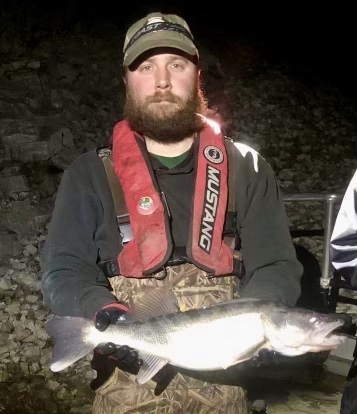Walleye were native to the White River before Beaver Lake and the other White River lakes (Table Rock and Bull Shoals) were built. Between 1964 and 1969, Beaver Lake was stocked with almost 6 million walleye, but these fish did not thrive in the lake.
In the late 1990s, the biologists on Beaver Lake were Ralph Fourt (District Biologist) and Ron Moore (Assistant Biologist). Both had extensive experience on Beaver Lake, with Ron having dedicated all of his 28-year career to managing the lake. During a recent interview, Ron mentioned that there was disagreement between the biologists regarding walleye stocking. Ralph opposed stocking walleye, fearing they would compete with the newly established smallmouth bass population. In contrast, Ron supported stocking walleye for the following reasons:
- Walleye were once native to the White River, and Ron believed they would greatly benefit anglers on the lake, especially since it is well known they make excellent table fare.
- Other lakes in Arkansas, such as Table Rock, Bull Shoals, Norfork, and Greers Ferry, had thriving walleye fisheries that produced large fish and were very popular among anglers. Notably, Greers Ferry Lake produced a world-record walleye in 1982, weighing 22 pounds 11 ounces.
Ron also noted that they received phone calls from anglers requesting walleye in Beaver Lake, but there was no directive from AGFC administration to stock the fish. Ron persisted and eventually gained support for the idea of stocking Walleye in the early 2000s. The walleye fishery in Beaver Lake is still very young. The first successful year class was produced in 2008, truly establishing the growing fishery. In 2020, the agency began stocking 100,000 fish every other year because research indicated that walleye typically do not produce strong year classes annually. A good year class one year often leads to less successful classes in subsequent years due to competition and predation from larger fish. Essentially, the agency aimed to maximize the effectiveness of its stocking efforts.
District 1 biologists conduct a walleye age sample every five years. These surveys show that the fish grow very quickly here. Most walleye reach the minimum length limit of 18 inches in 3-4 years, much faster than in the upper Midwest, where an 18-inch walleye can be six years old. This difference is attributed to more forage and a longer growing season in Arkansas compared to northern climates.
The walleye fishery in Beaver Lake is improving over time, though it is still young. Recent gill net samples indicate that the average size of walleye is increasing. In 2010, the largest walleye sampled was 23 inches (4 lbs.); in 2018, was 25 inches (5.1 lbs.); and in 2023, it was 26 inches (6.7 lbs.). Reports of fish over 7 pounds are becoming more common, and the size range is expected to improve with time. The presence of double-digit walleye in Table Rock and Bull Shoals is due to their much longer-established populations. The Table Rock walleye population has been around since at least 1960 (over 60 years), whereas Beaver Lake’s first strong year class was in 2008 (16 years). The Beaver Lake fishery is relatively new, but the increasing size distribution is promising.
District 1 biologists have collected extensive data on the growing walleye population in Beaver Lake. This information is being used to wisely manage the fishery, with one example being the decision to stock every other year to produce stronger year classes. Additionally, as fisheries managers, the goal is to provide good fishing opportunities for all anglers without favoring one species over another. A nine-month creel survey in 2021, involving over 600 individual interviews, revealed a diverse group of anglers on Beaver Lake targeting at least seven different species of fish.
